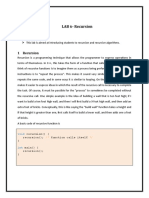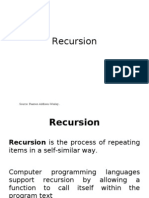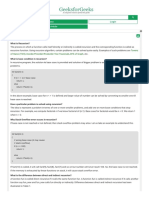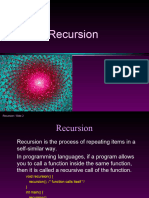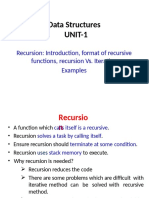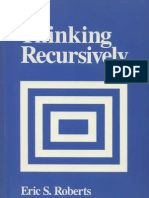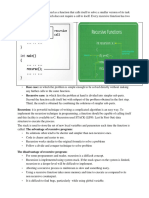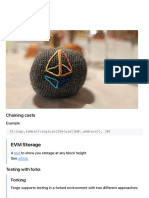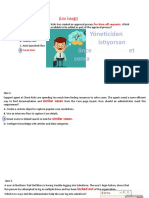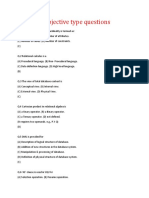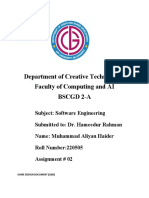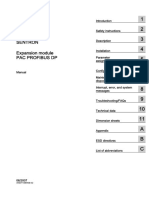Recursion
Recursion is a programming technique where a function calls itself in order to solve a problem. In
C, as in many programming languages, recursive functions are widely used, especially for solving
problems that can be broken down into smaller, similar sub-problems. Here's a basic introduction
to recursion in C:
Key Concepts of Recursion:
1. Base Case: A recursive function must have one or more base cases, which are the simplest
instances of the problem that can be solved directly without further recursion.
2. Recursive Case: In this case, the function calls itself with a modified version of the problem.
The goal is to eventually reach the base case.
3. Call Stack: When a function is called, the program stores information about the function's
state (local variables and return address) in a data structure called the call stack. This allows
the program to return to the correct point when the function call is completed.
Example of a Recursive Function:
Here's a simple example of a recursive function in C: calculating the factorial of a positive integer.
#include <stdio.h>
int factorial(int n) {
// Base case
if (n == 0) {
return 1;
}
// Recursive case
else {
return n * factorial(n - 1);
}
}
int main() {
int n = 5;
int result = factorial(n);
printf("Factorial of %d is %d\n", n, result);
return 0;
}
In this example, the factorial function calls itself with a smaller value (n - 1) until it reaches the
base case where n becomes 0. Then, it starts returning values back up the call stack, multiplying
them along the way.
�Advantages of Recursion:
1. Recursive code often closely mirrors the problem's natural structure.
2. Recursion can make complex problems more manageable and easier to understand.
3. It is suitable for problems with a recursive definition, like mathematical induction.
Considerations:
1. Recursion can lead to stack overflow errors if not properly managed.
2. It may not be the most efficient solution for all problems, and iterative solutions might be
faster.
To effectively use recursion, it's important to understand the problem, define appropriate base
cases, and design the recursive calls to converge toward the base cases. Recursion can be a
powerful tool for problem-solving when used wisely.
�Need of recursion
Recursion is a powerful programming technique that has various applications in C and other
programming languages. It is primarily used when a problem can be broken down into smaller,
similar sub-problems. Here are some scenarios in which recursion is particularly useful in C:
1. Mathematical Problems: Recursion is often used to solve mathematical problems with
recursive definitions, such as calculating factorials, Fibonacci numbers, and solving problems
involving sequences or mathematical induction.
2. Sorting Algorithms: Some sorting algorithms, like quicksort and mergesort, are
implemented using recursion. These algorithms divide the input into smaller parts and sort
them, which is a recursive process.
3. File System Operations: Recursion is used to traverse directories and subdirectories within
a file system. It's helpful for tasks like searching for files, counting files, or copying directory
structures.
4. Dynamic Programming: Many dynamic programming problems, like the knapsack problem
and the longest common subsequence problem, can be efficiently solved using recursion
with memoization (storing already computed results to avoid redundant calculations).
5. Backtracking Algorithms: In combinatorial problems, like solving puzzles (e.g., the N-
Queens problem or Sudoku), backtracking algorithms use recursive functions to explore all
possible solutions.
6. Complex Problem Decomposition: In general, recursion is useful for breaking down
complex problems into simpler, more manageable sub-problems. Each recursive call focuses
on a smaller part of the problem until a base case is reached.
Recursion is a versatile tool that simplifies problem-solving by mirroring the natural structure of
many problems. However, it's important to use recursion judiciously and consider the efficiency
and memory usage of recursive solutions. In some cases, iterative solutions may be more efficient
and practical.
�Example of recursion
Recursion is a common concept in everyday life, and you often encounter it in various situations
without even realizing it. Here's a simple and relatable life example of recursion:
1. Family Trees:
In a family tree, you start with a person (e.g., yourself) and branch out to your parents, then
to your grandparents, and so on.
Each generation follows the same pattern: individuals have parents who, in turn, have their
own parents.
This recursive structure continues throughout the family tree, with each person having a
lineage that can be traced back through multiple generations.
Consider this simplified family tree:
You (Generation 1)
Your Parents (Generation 2)
Your Grandparents (Generation 3)
Your Great-Grandparents (Generation 4)
...
This hierarchical structure, where each generation repeats the same pattern, is a real-world
example of recursion. Each individual is part of a generation, and the pattern repeats as you move
further back in time.
Recursion is a fundamental concept in understanding how generations are connected in a family
tree, and it can be applied to understanding relationships and ancestry in many cultures and
societies.
2. In human life, recursion is often observed in various processes and activities. Here's a life
example of recursion related to personal growth and learning:
Learning and Building Knowledge:
Consider the process of learning a new subject or skill, such as programming.
You start with basic concepts and gradually build your understanding by delving into more
advanced topics.
Each new topic you explore can be seen as a recursive process. For example, when learning
programming, you start with the basics (e.g., variables and loops).
As you progress, you move on to more complex topics like functions, data structures, and
algorithms.
The learning process repeats for each new concept or topic, where you start with the
fundamentals and then dive deeper into more advanced aspects.
This recursive learning process continues as you acquire more knowledge and expertise in
the subject.
Here's a simplified representation of the recursive learning process in programming:
1. Learn Basic Concepts
Variables
� Loops
Conditional Statements
2. Explore Intermediate Topics
Functions
Arrays
Objects
3. Dive into Advanced Topics
Data Structures (e.g., Linked Lists, Trees)
Algorithms (e.g., Sorting and Searching)
4. Continue Learning Specialized Areas
Web Development
Mobile App Development
Machine Learning
In this life example, the recursive pattern of learning is evident, where you start with foundational
knowledge and recursively build upon it to gain expertise in a particular subject or skill. This
process mirrors the concept of recursion used in programming and problem-solving, where you
break down complex tasks into smaller, manageable components and build your understanding
step by step.
4. In cooking, recursion can be observed in the preparation of many recipes, particularly
when it involves layering or stacking ingredients to create a dish. A classic example of
recursion in cooking is a "Lasagna" recipe:
Lasagna Recipe:
Lasagna is a layered pasta dish made by stacking multiple layers of pasta sheets, sauce,
cheese, and other ingredients.
Here's how this culinary example relates to recursion:
1. Base Layer: You start with a base layer of lasagna noodles at the bottom of a baking dish.
2. Recursive Layers:
On top of the base layer, you add a layer of sauce, typically tomato sauce or béchamel
sauce.
Then, you sprinkle a layer of cheese (e.g., mozzarella or Parmesan) on top of the sauce.
You can add other ingredients like vegetables, meat, or herbs as additional layers.
The process repeats by adding more lasagna noodles, sauce, cheese, and other
ingredients.
This layering continues until the baking dish is filled or until you've reached the desired
number of layers.
3. Baking: Once all the layers are assembled, the lasagna is baked in the oven until it's fully
cooked and the flavors meld together.
The recursive pattern in lasagna preparation involves stacking layers of similar ingredients, with
each layer resembling the previous one. This recursive approach is not limited to lasagna; it can be
seen in other layered dishes like casseroles, moussaka, or even desserts like trifle.
�5. Another example of recursion in cooking can be found in the preparation of "Stuffed Bell
Peppers." In this dish, recursion is evident in the process of filling bell peppers with a
mixture, and this process can be applied recursively to each individual pepper. Here's how
it works:
Stuffed Bell Peppers Recipe:
1. Prepare the Peppers:
Start by cutting the tops off bell peppers and removing the seeds and membranes to
create hollow shells.
2. Prepare the Filling:
Prepare a filling mixture, which often includes ingredients like ground meat, rice,
vegetables, and seasonings. This mixture serves as the base.
3. Recursive Stuffing:
Take each hollowed-out bell pepper and stuff it with the filling mixture.
The process of filling each pepper can be seen as a recursive step, where you apply the
same procedure to each individual pepper.
4. Stack and Arrange:
Arrange the stuffed peppers in a baking dish.
5. Baking:
Bake the stuffed bell peppers in the oven until they are cooked and the flavors meld
together.
The recursive aspect in this dish lies in the repetition of the process of filling for each individual
pepper. Each pepper is treated in a similar manner, creating a series of nested operations that
resemble the concept of recursion. This example highlights how recursion is not limited to
computer programming but is a concept that can be observed in various aspects of everyday life,
including cooking.
6. A daily routine involves repetitive tasks that can be thought of as a form of recursion.
Here's an example of a daily routine with recursive elements:
Morning Routine:
Wake Up:
Every day, you start your morning routine by waking up from sleep. This is the initial
step, or the base case, of your morning routine recursion.
Hygiene Routine:
Within your morning routine, you have a series of hygiene tasks, such as:
Brushing your teeth
Washing your face
Taking a shower
Applying skincare products
These tasks can be seen as repeated steps (recursive calls) that you perform daily.
Getting Dressed:
You select and put on your clothes for the day. This step also involves choosing specific
items and wearing them repeatedly.
�The recursive nature of a daily routine becomes evident when you consider that you perform
these steps in a similar order and often repeatedly each day. While each day may introduce slight
variations, the core structure of your routine remains recursive, with daily repetitions of the same
tasks, much like a recursive function that calls itself repeatedly to accomplish a specific task.
















